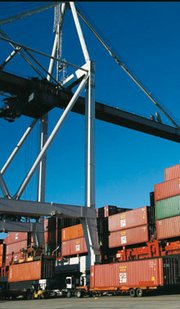Port Negotiations Resume, but Shippers Prepare for Sept. 30 Strike Deadline
Shades of the 2002 West Coast port strike loom over contract negotiations between East and Gulf Coast ports and longshore workers as talks resume Sept. 17 after a nearly one-month acrimonious rupture.
Retailers and apparel manufacturers of all sizes across the United States have started putting into place long-planned contingency plans—some formed as early as last April—if negotiators are not able to wrap up talks before the contract expires on Sept. 30.
“I know a number who, even prior to the Aug. 22 break-off of contract negotiations, started putting their contingency plans into motion to be safe,” said Jonathan Gold, vice president of supply chain and customs policy at the Washington, D.C.–based National Retail Federation, the world’s largest retail trade association. “Some of them were bringing cargo in early to make sure they didn’t get caught up in a strike that could happen Oct. 1. Some are shifting cargo to the West Coast ports, and some are shipping cargo to Halifax, Canada.
“Others are looking at the potential of air cargo, which, we have been told, costs eight to 10 times more than ocean freight.”
Gold didn’t know what percentage of NRF members were deploying their contingency plans. They were of all sizes—big-box, mid-size and specialty stores.
The contract negotiations between the International Longshoremen’s Association (ILA), the largest maritime union in the United States, which represents about 65,000 workers, and the United States Maritime Alliance (USMX)—which speaks for marine terminals, shipping lines and port associations from Maine to Texas—will cost retailers and apparel makers thousands of additional dollars in fees if a resolution doesn’t occur by Sept. 30.
All major cargo carriers plan to impose congestion surcharges effective Oct. 1 in order to protect themselves from any undue costs associated with port congestions. The fees will be nullified if a contract is worked out.
The surcharges, ranging from $800 per 20-foot container to $1,000 per standard 40-foot container, are applicable to all import and export shipments to and from Asia and Europe to all ports in North America.
Planning for the worst
Many carriers have been working with their clients since May to develop contingency plans. One ocean-carrier representative, who asked not to be named, said companies looking to alter routes should contact their sales representative at their ocean carrier and develop a plan. “The sales representative can identify where there is an opportunity [for space on a vessel] and the costs associated with it,” he said.
Many apparel companies shipping from China to the East Coast prefer to go the all-water route through the Panama Canal instead of unloading cargo at the ports of Los Angeles or Long Beach, Calif., and then loading containers onto trucks or rail cars heading east.
Most of that rail cargo is carried either by Union Pacific or the Burlington Northern Santa Fe. Krista York-Woolley, a BNSF spokesperson, said the railroad company has plenty of capacity to handle any extra freight that may end up coming through West Coast ports. “Most of the cargo owners, such as Target and Wal-Mart, work through their ocean carriers to arrange to get goods across the country. The ocean carriers, in turn, work with the trucking industry and railroad.”
Already, the Southern California ports of Los Angeles and Long Beach handle 42 percent of the ocean-going freight that comes to the United States, but those ports are prepared to handle more volume because their cargo traffic is off 7 percent to 17 percent of their 2006 and 2007 peaks. Still, in a recent interview, Thomas Knudsen, Maersk Line’s Asia Pacific chief executive, said shippers seeking to divert shipments into West Coast ports will find capacity scarce. The shipper can handle a little more but not a major overflow.
Forced talks
Labor negotiations that started in March seemed to be going well, with both sides stating they were confident they would have a new contract by Sept. 30. The two sides quickly agreed on two key issues: chassis and automation.
But the talks soured when the USMX requested a change of work rules that included reducing overtime pay, not receiving a full day’s pay for less than eight hours of work and adjusting container royalties.
Since the Aug. 22 breakdown in talks, there has been some barbed communication going back and forth between the two sides. Harold Daggett, president of the longshore union, sent a letter to the USMX demanding a final pay offer to be sent to the union’s wage scale committee.
In an email and letter sent by FedEx responding to the union, James Capo, chairman and chief executive of the USMX, said he wanted to have some kind of discussion on economic issues before a final wage plan was offered.
With no talks scheduled for weeks, the government’s Federal Mediation and Conciliation Service on Sept. 6 ordered the two sides to resume negotiations at an undisclosed location.
Nevertheless, talks could break off again. David Lapidus, the transportation liaison at the American Apparel & Footwear Association, wrote in a newsletter that the situation is still precarious. “Though this development is a step in the right direction, the situation remains volatile,” he noted, “as either party may exit mediation as they see fit.”
Many remember the chaos and economic burden that occurred during a 10-day lockout at ports up and down the West Coast in the fall of 2002, right before the all-important Holiday shopping season.
Hundreds of California manufacturers sourcing in China and other Asian countries didn’t receive their goods on time, incurring millions of dollars in chargeback fees from retailers. Economists estimate the lockout, tied over a dispute involving new technology and jobs, cost $1 billion a day as agricultural exports either rotted on the docks or couldn’t be shipped and manufacturers didn’t receive parts to make products.























